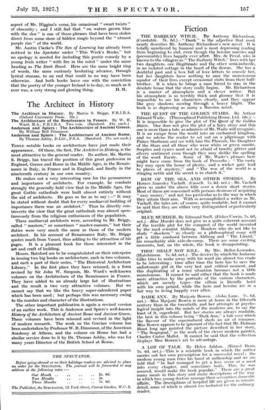The Architect in History
The Architect in History. By Martin S. Briggs, F.R.I.B.A. (Oxford University Press. 10s.)
The Architecture of the Renaissance in France. By W. H.
By William Bell Dinsmoor.
Anderson and Spiers : The Architecture of Ancient Rome. By Thomas Ashby, D.Litt., F.S.A. (Batsford. 21s. net each.)
Tim= notable books on architecture have just made their appearance. Of these, the first, The Architect in History, is the most attractive to the general reader. Its author, Mr. Martin S. Briggs, has traced the position of this great profession in England, Greece and Rome in the Middle Ages, in the Renais- sance in Italy, in France and in England, and finally in the nineteenth century in our own country.
He makes out a very interesting case for the permanence and importance of architects. For example, he combats
strongly the generally held view that in the Middle Ages, the great Gothic cathedrals were built almost entirely without the aid of architects. He goes so far as to say :—" It may be stated without doubt that for every mediaeval building of importance there was an architect." Thus he directly con- troverts the view that the great cathedrals rose almost spon- taneously from the religious enthusiasm of the population.
These mediaeval architects were, according to Mr. Briggs, called " masters," or sometimes " master-masons," but their duties were very much the same as those of the modern architect. In his account of Renaissance Italy, Mr. Briggs quotes much from Vasari, thus adding to the attraction of his pages. It is a pleasant book for those interested in the art and craft of building.
Messrs. Batsford are to be congratulated on their enterprise in issuing two big books on architecture, each in two volumes, and each a part of their series, " The Historical Architecture
Library." In the first place they have reissued, in a form revised by Sir John W. Simpson, Mr. Ward's well-known volumes on the Architecture of the Renaissance in France. They have added to an already large list of illustrations and the result is two very attractive volumes. But we cannot say that we like the heavy super-calendered paper which has been used ; but perhaps this was necessary owing to the number and character of the illustrations.
The other important publication is again a revised version of an earlier work. This is Anderson and Spiers's well-known History of the Architecture of Ancient Rome and Ancient Greece.
These volumes have been reissued and revised in the light of modern research. The work on the Grecian volume has been undertaken by Professor W. B. Dinsmoor, of the American Academy at Athens, and the volume on Rome has had a similar service done to it by Dr. Thomas Ashby, who was for many years Director of the British School at Rome.






















































 Previous page
Previous page